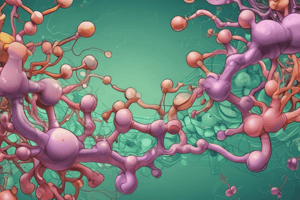Podcast
Questions and Answers
What type of chemical bond involves the sharing of electron pairs between atoms?
What type of chemical bond involves the sharing of electron pairs between atoms?
- Nonpolar covalent bond (correct)
- Polar covalent bond (correct)
- Hydrogen bond
- Ionic bond
Water is considered a reactive substance.
Water is considered a reactive substance.
False (B)
How many valence electrons does carbon have?
How many valence electrons does carbon have?
4
The maximum number of electrons that can fill the outer shell of an atom is typically _____.
The maximum number of electrons that can fill the outer shell of an atom is typically _____.
Match the type of chemical bond with its description:
Match the type of chemical bond with its description:
What is the smallest unit of matter that retains the properties of an element?
What is the smallest unit of matter that retains the properties of an element?
All molecules are compounds.
All molecules are compounds.
What are the three basic particles that make up an atom?
What are the three basic particles that make up an atom?
The # of protons in an atom determines its ________.
The # of protons in an atom determines its ________.
What does the Bohr model of the atom resemble?
What does the Bohr model of the atom resemble?
Match the following particles with their characteristics:
Match the following particles with their characteristics:
Electrons have a mass of 1 atomic mass unit (amu).
Electrons have a mass of 1 atomic mass unit (amu).
Matter is anything that takes up __________ and has mass.
Matter is anything that takes up __________ and has mass.
What does Le Chatelier’s Principle explain?
What does Le Chatelier’s Principle explain?
Reducing the concentration of reactant A will shift the equilibrium to the right.
Reducing the concentration of reactant A will shift the equilibrium to the right.
Why are chemical reactions important?
Why are chemical reactions important?
Organic compounds contain carbon covalently bound to ______.
Organic compounds contain carbon covalently bound to ______.
Match the following types of compounds with their characteristics:
Match the following types of compounds with their characteristics:
What is the primary feature of macromolecules?
What is the primary feature of macromolecules?
Inorganic compounds can contain carbon as long as there are no carbon-hydrogen bonds.
Inorganic compounds can contain carbon as long as there are no carbon-hydrogen bonds.
What are the two types of compounds discussed, and how do they differ?
What are the two types of compounds discussed, and how do they differ?
What type of bond is formed between a hydrogen atom and an electronegative atom?
What type of bond is formed between a hydrogen atom and an electronegative atom?
Hydrogen bonds are very strong and cannot be disrupted easily.
Hydrogen bonds are very strong and cannot be disrupted easily.
What molecules are commonly involved in hydrogen bonding within biological systems?
What molecules are commonly involved in hydrogen bonding within biological systems?
Hydrogen bonds often occur between molecules containing _____ or _____ atoms.
Hydrogen bonds often occur between molecules containing _____ or _____ atoms.
Match the following concepts related to hydrogen bonds:
Match the following concepts related to hydrogen bonds:
Which type of bond is primarily responsible for the structure of water?
Which type of bond is primarily responsible for the structure of water?
Attractions between two or more molecules are only due to covalent bonds.
Attractions between two or more molecules are only due to covalent bonds.
Explain how hydrogen bonds form between water molecules.
Explain how hydrogen bonds form between water molecules.
Which of the following biomolecules is responsible for encoding and transmitting genetic information?
Which of the following biomolecules is responsible for encoding and transmitting genetic information?
Proteins act as the primary source of energy for cells.
Proteins act as the primary source of energy for cells.
What are the four classes of large biomolecules found in living cells?
What are the four classes of large biomolecules found in living cells?
The macromolecules are complex molecules made up of repeated simpler units called __________.
The macromolecules are complex molecules made up of repeated simpler units called __________.
Match the following biomolecules with their main characteristics:
Match the following biomolecules with their main characteristics:
Which of the following is NOT a type of biomolecule?
Which of the following is NOT a type of biomolecule?
Proteins are considered polymers made from amino acid monomers.
Proteins are considered polymers made from amino acid monomers.
What are the building blocks of proteins?
What are the building blocks of proteins?
What is the main reason water has such a high heat capacity?
What is the main reason water has such a high heat capacity?
Water can dissolve both small ionic compounds and large polar compounds.
Water can dissolve both small ionic compounds and large polar compounds.
What is the significance of water's high heat capacity for living organisms?
What is the significance of water's high heat capacity for living organisms?
Water molecules have a strong tendency to stick to each other, a property known as ______.
Water molecules have a strong tendency to stick to each other, a property known as ______.
Which of these is NOT a way water contributes to the function of living organisms?
Which of these is NOT a way water contributes to the function of living organisms?
Match the following terms with their definitions:
Match the following terms with their definitions:
Water's high heat capacity means that it requires less heat energy to change its temperature compared to other substances.
Water's high heat capacity means that it requires less heat energy to change its temperature compared to other substances.
In the context of chemical reactions, what role can water play?
In the context of chemical reactions, what role can water play?
Flashcards
Chemical Bond
Chemical Bond
An attraction between atoms that holds them together in a molecule.
Valence Electrons
Valence Electrons
Electrons in the outermost shell of an atom, important for bonding.
Ionic Bonds
Ionic Bonds
Chemical bonds formed through the transfer of electrons between atoms.
Covalent Bonds
Covalent Bonds
Signup and view all the flashcards
Emergent Properties
Emergent Properties
Signup and view all the flashcards
Biomolecules
Biomolecules
Signup and view all the flashcards
Lipids
Lipids
Signup and view all the flashcards
Nucleic Acids
Nucleic Acids
Signup and view all the flashcards
Atoms
Atoms
Signup and view all the flashcards
Carbohydrates
Carbohydrates
Signup and view all the flashcards
Elements
Elements
Signup and view all the flashcards
Proteins
Proteins
Signup and view all the flashcards
Molecules
Molecules
Signup and view all the flashcards
Monomers
Monomers
Signup and view all the flashcards
Polymers
Polymers
Signup and view all the flashcards
Compounds
Compounds
Signup and view all the flashcards
Nucleus
Nucleus
Signup and view all the flashcards
Examples of Polymers
Examples of Polymers
Signup and view all the flashcards
Protons and Neutrons
Protons and Neutrons
Signup and view all the flashcards
Electron Cloud
Electron Cloud
Signup and view all the flashcards
Atomic Mass Unit (amu)
Atomic Mass Unit (amu)
Signup and view all the flashcards
Hydrogen Bonds
Hydrogen Bonds
Signup and view all the flashcards
Weak Hydrogen Bonds
Weak Hydrogen Bonds
Signup and view all the flashcards
Polar Covalent Bonds
Polar Covalent Bonds
Signup and view all the flashcards
Electronegative Atom
Electronegative Atom
Signup and view all the flashcards
O-H Bonds
O-H Bonds
Signup and view all the flashcards
N-H Bonds
N-H Bonds
Signup and view all the flashcards
Collective Strength of H-bonds
Collective Strength of H-bonds
Signup and view all the flashcards
H-bonds in Biology
H-bonds in Biology
Signup and view all the flashcards
Cohesion
Cohesion
Signup and view all the flashcards
Good Solvent
Good Solvent
Signup and view all the flashcards
Reactivity in Water
Reactivity in Water
Signup and view all the flashcards
High Heat Capacity
High Heat Capacity
Signup and view all the flashcards
Hydrogen Bonds in Heat Capacity
Hydrogen Bonds in Heat Capacity
Signup and view all the flashcards
Temperature Regulation
Temperature Regulation
Signup and view all the flashcards
Lubrication
Lubrication
Signup and view all the flashcards
Polar Nature of Water
Polar Nature of Water
Signup and view all the flashcards
Le Chatelier’s Principle
Le Chatelier’s Principle
Signup and view all the flashcards
Equilibrium
Equilibrium
Signup and view all the flashcards
Reactants
Reactants
Signup and view all the flashcards
Products
Products
Signup and view all the flashcards
Organic Compounds
Organic Compounds
Signup and view all the flashcards
Inorganic Compounds
Inorganic Compounds
Signup and view all the flashcards
Macromolecules
Macromolecules
Signup and view all the flashcards
Study Notes
Lecture 3: Chemistry & Biomolecules
- Lecture 3 covered chemistry and biomolecules.
- Additional resources were provided for further study: Martini, Nath, and Bartholomew (2017), Fundamentals of Anatomy and Physiology, pages 27-40, and various OpenStax resources.
- Review of Lecture 3 and Assignment #2 (Chemistry) were assigned for the next class.
- Lab 2 (Bones of the Skeletal system) and Lab 3 (Joints) readings were also assigned.
Learning Objectives (Lecture 2)
- Review key chemical terms: atom, element, molecule, macromolecule, organic/inorganic compound, ionic bond, covalent bond, polar covalent, ion, acid, base, buffer, pH, and salt.
- Define terms: anabolism, synthesis, catabolism, and decomposition.
- Explain water's importance:
- Describe water's structure.
- Explain why water is a polar molecule (include a diagram).
- Define and diagram a hydrogen bond.
- List and explain the functions of water supporting life.
- Define monomer, polymer, and macromolecule.
- Describe dehydration synthesis reactions using examples.
- Describe hydrolysis reactions using examples.
Basic Particles of Matter
- Atoms: The smallest unit of matter retaining element properties. Made of protons, neutrons, and electrons.
- Elements: Pure substances of one atom type identified by atomic number (protons), found on the periodic table with chemical symbols (e.g., Oxygen, Hydrogen, Nitrogen).
- Molecules: Two or more atoms bonded together.
- Compounds: Formed when two or more different elements bond, all compounds are molecules but not all molecules are compounds (e.g., water, carbon dioxide).
- Matter: Anything that occupies space and has mass.
The Atom
- Bohr model resembles a solar system, with negatively charged electrons orbiting a dense nucleus.
- Nucleus contains positively charged protons and neutral neutrons.
- Quantum mechanics expanded understanding of atoms with orbital theory; existence of electron clouds.
- Atoms are mostly empty space.
- Mass of a proton and neutron is 1 atomic mass unit (amu).
- Electrons have no mass (0 amu).
- Atomic number = number of protons. This determines the atom's identity and arrangement on the periodic table.
- Atomic mass = sum of protons and neutrons.
Isotopes
- Isotopes are versions of atoms of the same element but have different numbers of neutrons.
- Different isotopes have different atomic masses.
- Some isotopes are stable, while others are radioactive and unstable.
- Radioactive isotopes have biological applications, like carbon dating for fossils, nuclear medicine, radioactive tracers, and radiotherapy.
Chemical Bonds
- Chemical bond: an attraction between atoms that holds them together
- Types of bonds:
- Ionic bonds: complete electron transfer between atoms, forming ions.
- Covalent bonds: atoms share electrons (polar and nonpolar- in polar covalent, electrons are shared unevenly).
- Hydrogen bonds: weak attractions between a partially positive hydrogen atom and a partially negative atom (Oxygen or Nitrogen) in another molecule.
- Electronegativity: the ability of an atom to attract electrons. Higher electronegativity = greater ability to attract electrons.
Chemical Reactions
- Chemical reaction: atoms in compounds rearranging to form new substances with new properties.
- Evidence of a chemical reaction: Heat production, color changes, precipitate formation, gas production.
- Types of reactions:
- Exergonic: releases energy/ spontaneous (e.g., cellular respiration).
- Endergonic: requires energy (e.g., muscle growth).
- Metabolism: The sum of all chemical processes in organisms including both catabolic and anabolic pathways (catabolism: breaking down and anabolism: building up)
- ATP: The primary energy currency used in cells (Adenosine triphosphate), involved in energy coupling.
Importance of Water
- Water is polar, allowing hydrogen bonding between water molecules. This unique characteristic gives water many special properties (such as cohesion, adhesion, a good solvent, reactivity, high specific heat, lubrication).
- Hydrophilic compounds dissolve in water.
- Hydrophobic compounds do not dissolve in water.
- Water's cohesion and adhesion are important for many biological processes.
- Water’s high specific heat helps to regulate temperature in organisms.
Acids & Bases
- Water dissociation: Water spontaneously breaks down into H⁺ and OH⁻ ions in a solution.
- Acids: Substances that release H⁺ ions when in water.
- Bases: Substances that accept H⁺ ions when in water.
- pH Scale: 0 to 14 scale measuring the concentration of H⁺ and OH⁻ ions in a solution (0-7 acidic, 7 neutral, 7-14 basic)
- Buffers: Solutions that resist changes in pH.
Introduction to Biomolecules
- Major macromolecules:
- Lipids: create cell membranes and store long-term energy.
- Nucleic acids: encode and transmit genetic information.
- Carbohydrates: provide energy.
- Proteins: have many functions including pores/pumps for transport and enzymes that speed up reactions.
- Monomers are the single units from which polymers are constructed.
Assignment #2: Atoms, Chemical Bonds, and Reactions
- Questions regarding identifying compounds, calculating the number of subatomic particles for various elements, drawing models of water interacting with hydrogen bonds, and identifying likely polar covalent compounds from structural formulas.
Studying That Suits You
Use AI to generate personalized quizzes and flashcards to suit your learning preferences.




